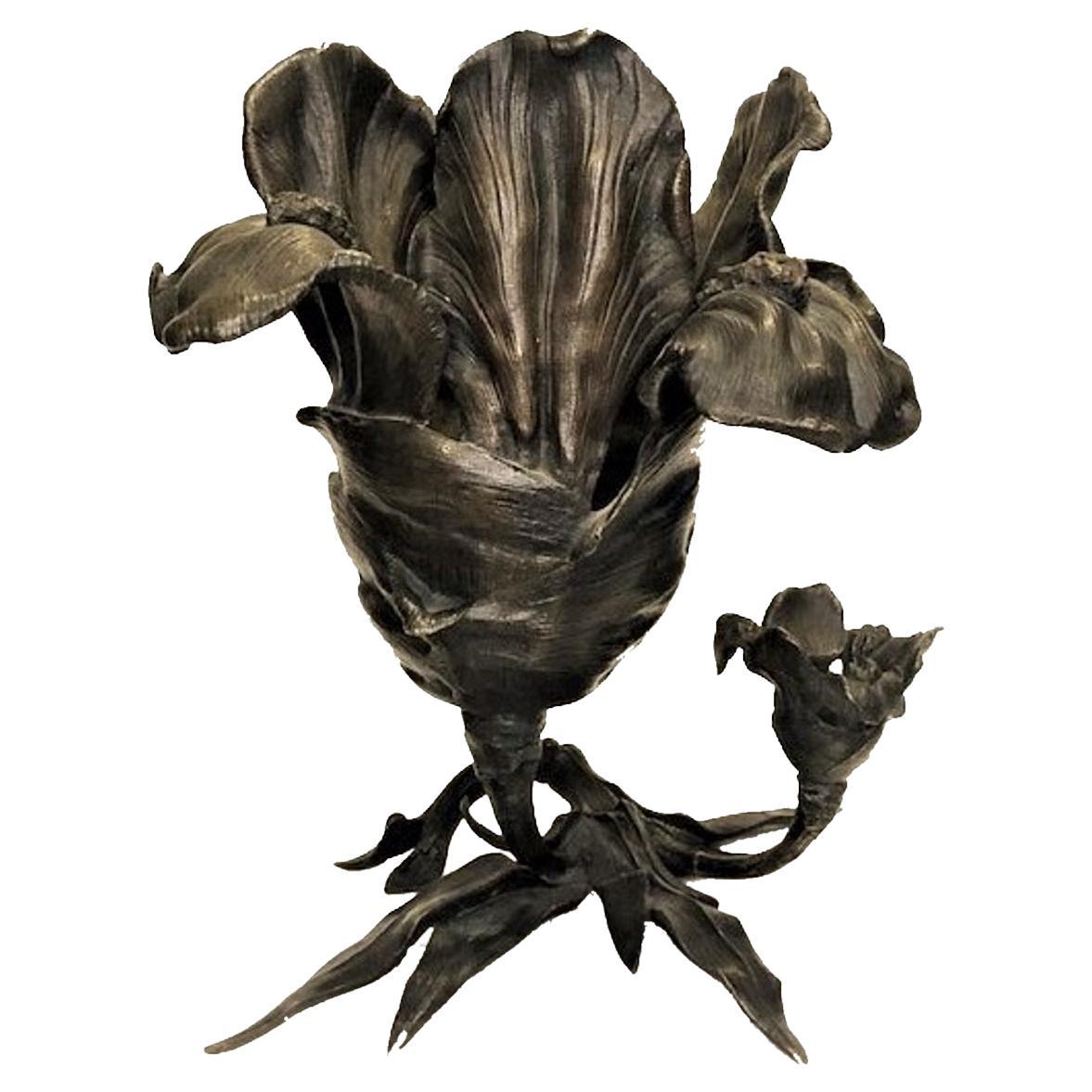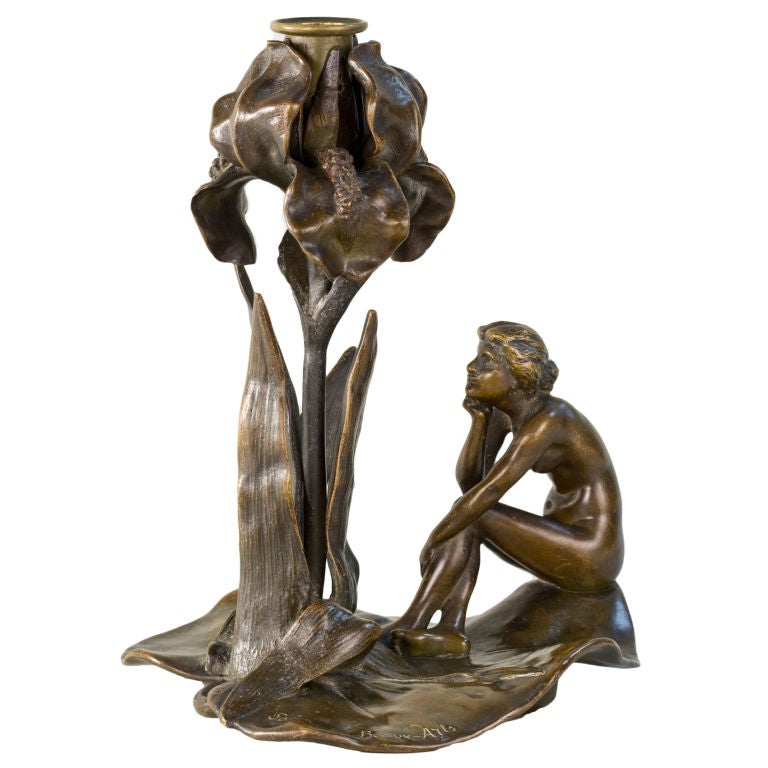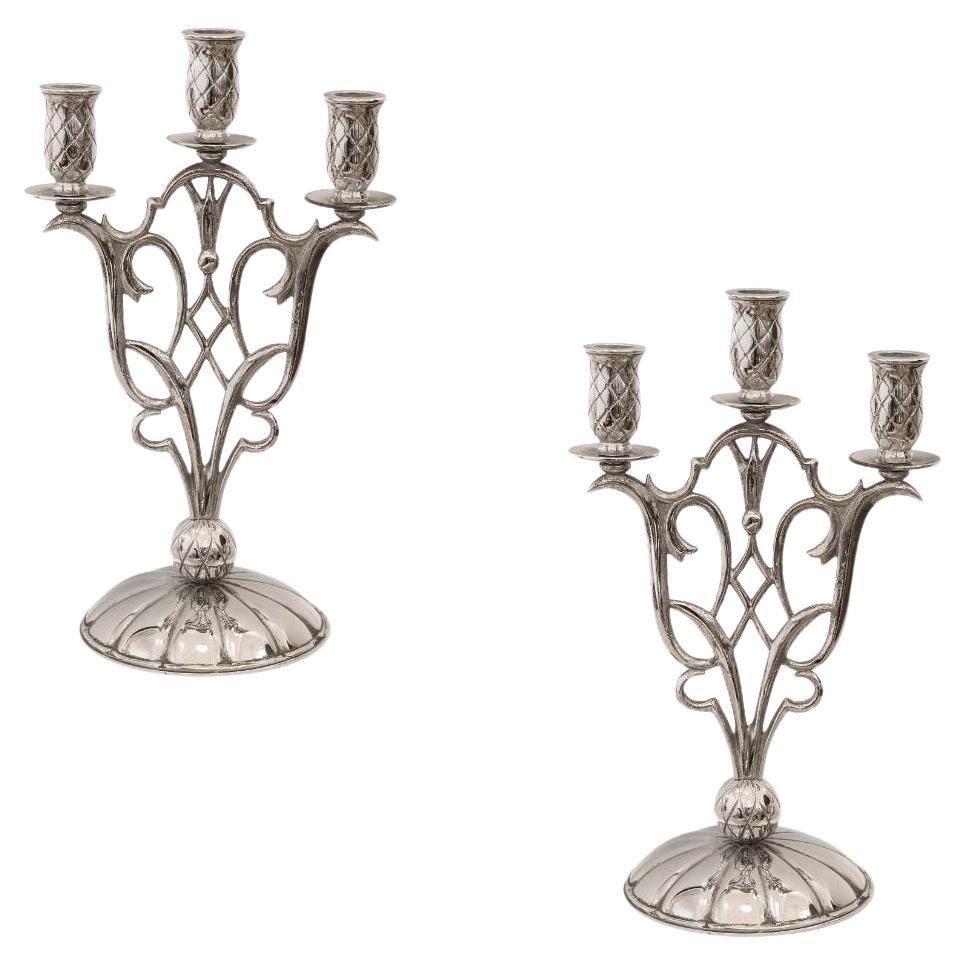Items Similar to French Art Nouveau Grand Bronze Iris Candelabra, ca. 1900
Want more images or videos?
Request additional images or videos from the seller
1 of 12
French Art Nouveau Grand Bronze Iris Candelabra, ca. 1900
About the Item
ABOUT IRIS MOTIFS
Iris motifs were popular during the Arts & Crafts movement. The genus of this easy-to-stylize flower has nearly 300 varieties that bloom in many colors—thus its name came from Iris, the Greek goddess of the rainbow, who linked heaven and earth. In many cultures, the iris has symbolized luck, and also friendship and the promise of love.
It’s often said that the flower’s three upright petals stand for faith, valor, and wisdom. In Christian symbolism, the blade-like leaves suggest the sorrows that pierced Mother Mary’s heart.
In Chinese, the word for iris means “purple butterfly,” and the flower is associated with the softness of early summer. Despite its name, the fleur-de-lys (“flower of the lily”) is clearly derived from an iris flower, and has been associated with the French monarchy and France since the Middle Ages.
Related to aquatic motifs such as the dragonfly and carp (koi), the iris was often used as a decorative design in the Aesthetic, Art Nouveau, and Arts & Crafts movements; the fascination with water motifs came from the influence of Japanese design on European decorative arts after the reopening of trade in 1854.
DIMENSIONS:
Height: 30.5 inches
Width: 16.5 inches
Depth: 9.25 inches
- Dimensions:Height: 30.5 in (77.47 cm)Width: 16.5 in (41.91 cm)Depth: 9.25 in (23.5 cm)
- Style:Art Nouveau (Of the Period)
- Materials and Techniques:Bronze,Cast
- Place of Origin:
- Period:1900-1909
- Date of Manufacture:ca. 1900
- Condition:Wear consistent with age and use. We make our best effort to provide a fair and descriptive condition report. Please examine photos attentively, as they are part of the description. Send us a message to request more details or discuss price.
- Seller Location:New York, NY
- Reference Number:1stDibs: LU2819335069962
About the Seller
5.0
Vetted Seller
These experienced sellers undergo a comprehensive evaluation by our team of in-house experts.
Established in 1993
1stDibs seller since 2017
68 sales on 1stDibs
Typical response time: 2 hours
- ShippingRetrieving quote...Ships From: New York, NY
- Return PolicyA return for this item may be initiated within 10 days of delivery.
More From This SellerView All
- French Art Nouveau Patinated Bronze Sculptural Iris Vase, ca. 1900Located in New York, NYABOUT IRIS The iris is a special and mysterious flower. Not only because of its striking appearance, but also from an artistic and historical point of view. It is also like a work of art, as though created by Mother Nature. The unique leaves of this plant not only create wonderful shadow casts, but also look as if they were painted by hand. It's no wonder that iris acts as the muse for countless artists, and can be seen in many famous works of art. The iris was first spotted in the time of Pharaoh Thutmose, in 1504 BC. He had the iris inscribed into the wall reliefs of a temple as a sign of his power, as well as decorating his sceptre with motifs of the flower. Since then, the iris has been a symbol of victory in Egypt. But the symbolism of the iris goes further than that. In Japan, the flower represents courage and is the symbol of the boys' festival. In Islamic cultures, the iris is a symbol of prosperity. In Europe, the flower was a popular weapon symbol in the Middle Ages and stood for chivalry. And in Christianity, the iris was seen as a symbol of the trinity because of its three-part flowers. With more than 300 varieties, the iris is now the most popular flower among growers and gardeners following the rose. Countless artists use the iris in their works and the flower is present in all eras. You can see the flower on furniture, vases, jewelry, fabrics, sculptures, coats of arms and much more. Did you know that the iris is also called the sword lily? It's not a coincidence that it used to symbolize physical and emotional pain and suffering caused by a weapon. We also see the flower in religious art, where it's often associated with Mary and Jesus. The iris is also associated with the Greek goddess Iris, where the flower symbolizes reconciliation and divine messages. This is also reflected in many paintings. Finally, the iris is also visible in Dutch and Flemish still-life paintings. This can be in a religious form, incorporated into an object or as a decorative flower. In the Art Nouveau art movement, the iris (along with other plants, such as the birch) was often used as an expression of feminine beauty. With its almost otherworldly appearance, the iris is perfectly suited to the Art Nouveau aesthetic and is featured in many well-known works of art. The poet of that era, Hermann Hesse...Category
Antique Early 1900s French Art Nouveau Planters, Cachepots and Jardinières
MaterialsBronze
- Pair of Japanese Patinated Bronze Candelabras, Meiji Period, ca. 1900Located in New York, NYThis most unusual pair of original 18th century Japanese patinated bronze candelabras, uniquely designed as branches of mountain flowers entangled by a dragon, are mounted on the con...Category
Antique Late 19th Century Japanese Japonisme Candelabras
MaterialsBronze
- Pair of American Rococo Revival Patinated Bronze Candelabras, Ca. 1825Located in New York, NYBronze, dark-brown patina, unmarked. Measures: Height: 23” Width: 14” The notion of an “American Rococo” seems a contradiction in terms. The very word rococo is as French as Camembert. It connotes a style that reigned along with Louis XV in the aristocratic decadence of the 18th Century. It was garlanded, nonchalant, associated with erotic marshmallow nudes by Francois Boucher and foppish courtiers costumed as shepherds pretending they understood Jean-Jacques Rousseau when all they really wanted was romantic dalliance in the formal gardens of Versailles. In the history of painting it produced but one great artist, Antoine Watteau. By contrast, Americans of the period are remembered as the flinty inheritors of New England Puritans, full of rectitude and having not a moment for furbelow or frippery. Such few painters as were around included hard-nosed realists like John Singleton Copley and Charles Willson Peale. Well, as it turns out, life once again acts according to the principle of paradox. There was an American rococo. It came to us indirectly via England disguised under the name Chippendale. Now for the first time the style receives comprehensive survey in the exhibition “American Rococo, 1750-1775: Elegance in Ornament.” Jointly organized by New York’s Metropolitan Museum and the Los Angeles County Museum of Art, it opens here Sundaywith a spread of some 170 works of decorative art and a conscientious catalogue with essays by Met and LACMA curators Morrison H. Heckscher and Leslie Greene Bowman. There are at least two ways of looking at the decorative arts. Connoisseurs appreciate their design and craftsmanship. Those of sociological bent examine objects of material culture for their revelations of history and the temper of the times. Actually neither view is complete without the other. Stylistically the rococo reveals a longing for intimacy in its small scale and an urge to organic nature in its love of stylized vines, tendrils, tiny flowers and seashells. If it were a new manner being promoted by Madison Avenue today it would probably be called “Baroque Lite.” There is an ease about the style that makes it airy, but it has an underlying formality that bespeaks lives of gentrified cultivation rather than beer-bellied sloth. It’s fascinating to examine the flintlock firearms on view and find these weapons of death shaped and decorated with the most exquisite care by wood carvers and metal engravers. All of this is completely consistent with the main currents of 18th-Century European thought. In France, Rousseau sang the virtues of nature and the noble savage like a present-day ecologist. In England, John Locke...Category
Antique 1820s American Rococo Revival Candelabras
MaterialsBronze
- A Pair of Bronze Neoclassical Grand Tour Candelabras, Late 19th CenturyLocated in New York, NYGrand Tour Pair of Bronze Candelabras Late 19th Century DIMENSIONS Height: 10.33 inches Width: 4.75 inches Depth: 4.75 inches ABOUT We present to your attention a pair of stunning...Category
Antique 1890s English Grand Tour Candelabras
MaterialsBronze
- French Art Nouveau Iridescent Stoneware & Bronze Vase or Cachepot, ca. 1900sLocated in New York, NYFrench Art Nouveau Ocean Life Theme Vase Cachepot Iridescent Stoneware & Patinated Bronze Crab Appliqué ca. 1900s ABOUT We present here a most unusual and utterly decorative Fren...Category
Antique Early 1900s French Art Nouveau Vases
MaterialsStoneware
- Paul Loiseau-Rousseau, French Art Nouveau Gilt Bronze Jug, Ca. 1900By Paul Loiseau-Rousseau 1Located in New York, NYPaul Louis Emile Loiseau-Rousseau (French, 1861-1927) was a famous French sculptor. In his youth, he planned to devote himself to etching, was a student of Antoine-Louis Barye at the...Category
Antique Early 1900s French Art Nouveau Vases
MaterialsBronze
You May Also Like
- Art Nouveau French Brass Floral Candelabra, circa 1900Located in Pearland, TXA gorgeous antique Art Nouveau French solid brass candelabra with four candle holders. This stylish candelabra is solid and heavy, weighing a substantial 3 lbs 10 oz, with a beautifu...Category
Antique Early 1900s French Art Nouveau Candelabras
MaterialsBrass
- French Art Nouveau Bronze Iris Candlestick by JozonBy Jeanne JozonLocated in Englewood, NJFrench Art Nouveau bronze iris candlestick by Jozon, depicting a nude womanl sitting on a lily pad gazing towards the iris. It is signed, "J. Jozon” a...Category
20th Century French Candle Holders
MaterialsBronze
- Big Pair of Candelabras, Jugendstil, Art Nouveau, France, 1900, Sign, ChristofleBy ChristofleLocated in Ciudad Autónoma Buenos Aires, CCenterplace, Sign: Christofle Metal: Silver plated We have specialized in the sale of Art Deco and Art Nouveau and Vintage styles since 1982.If you have any questions we are at you...Category
Antique Early 1900s French Art Nouveau Candelabras
MaterialsMetal
- Pair of Candelabras in Iron, France, 1900, Jugendstil, Art Nouveau, LibertyLocated in Ciudad Autónoma Buenos Aires, CCandelabra Jugendstil, Art Nouveau, Liberty We have specialized in the sale of Art Deco and Art Nouveau and Vintage styles since 1982. If you have any questions we are at your disp...Category
Antique Early 1900s French Art Nouveau Candelabras
MaterialsIron
- French Wrought Iron Floor Candelabra, ca. 1900Located in Atlanta, GAFrench wrought iron floor candelabra with gilt paint accent, ca. 1900.Category
Early 20th Century European Torchères
MaterialsWrought Iron
- Art Nouveau sterling silver candelabras, 1900-1920Located in Delft, NLArt Nouveau sterling silver candelabras, 1900-1920 A pair of candelabras in sterling silver in Art Nouveau style. This model was designed by Albert Mayer, Sculptor and Designer. The design of Albert Mayer is the "Eiffel" in Germany and Albert Mayer was employed and director at WMF (1884-1914). These candelabras, designed by Albert, were made of base material such as silver plated, brass, or pewter. These you see are candelabras are sterling silver, which are not made in Germany, but in America. Joseph and his brothers, Albert and Marcus Mayer, emigrated from Germany and established a business in Seattle, Washington, in about 1895. Joseph Mayer...Category
Early 20th Century American Candelabras
MaterialsSterling Silver
Recently Viewed
View AllMore Ways To Browse
Lars Bergsten On Sale
Marble Brevettato
Neoclassical Sterling Candle Sticks
Pair Of Baccarat Glass Hurricane Candelabra
Peacock Royal Nymphenburg
Puiforcat Candle
Versace Candelabra
Sienna Marble Candelabra
Baccarat Dolphin
Deer Candelabra
Spin Candelabra
Pomegranate Candelabra
Baccarat Hurricane
Mexican Sterling Candelabra
Mexico Sterling Silver Candelabra
Sterling Silver Mexican Candelabra
Menorah 7
Arthur Umanoff Candelabra





